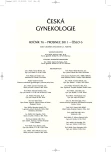Possibilities of 4D ultrasonography in imaging of the pelvic floor structures
Authors:
K. Dlouhá; L. Krofta
Authors‘ workplace:
Ústav pro péči o matku a dítě, Praha, ředitel doc. MUDr. J. Feyereisl, CSc.
Published in:
Ceska Gynekol 2011; 76(6): 450-452
Category:
Original Article
Overview
Technological boom of the last decades brought urogynaecologists and other specialists new possibilities in imaging of the pelvic floor structures which may substantially add to search for etiology of pelvic floor dysfunction. Magnetic resonance imaging (MRI) is an expensive, less accessible method and may pose certain dyscomphort to the patient. 3D/4D ultrasonography overcomes these disadvantages and brings new possibilities especially in dynamic, real time imaging and consequently enables focus on functional anatomy of complex of muscles and fascial structures of the pelvic floor. With 3D/4D ultrasound we can visualise urethra and surrounding structures, levator ani and urogenital hiatus, its changes during muscle contraction and Valsalva manévre. This method has great potential in diagnostics of pelvic organ prolapse, it may bring new knowledge of factors contributing to loss of integrity of pelvic floor structures resulting in prolapse and incontinence. Studies exist which describe changes in urogenital hiatus after vaginal delivery, further studies of large numbers of patients during longer period of time are though necessary so that conclusions can be drawn for clinical praxis.
Key words:
3D/4D ultrasonography, levator ani, pelvic organ prolapse.
Sources
1. DeLancey, JO., Kearney, R., Chow, Q., et al. The appearance of levator ani muscle abnormalities in magnetic resonance images after vaginal delivery. Obstet Gynecol, 2003, 101, p. 46-53.
2. Dietz, HP. Ultrasound imaging of the pelvic floor. Part I: two dimensional aspects. Ultrasound Obstet Gynecol, 2004, 23, p. 80‑92.
3. Dietz, HP. Ultrasound imaging of the pelvic floor. Part II: three dimensional or volume imaging. Ultrasound Obstet Gynecol, 2004, 23, p. 615-625.
4. Dietz, HP., Shek, C., Clarke, B. Biometry of the pubovisceral muscle and levator hiatus by three-dimensional pelvic floor ultrasound. Ultrasound Obstet Gynecol, 2005, 25, p. 580-585.
5. Petros, P., Ulmsten, U. An integral theory and its method for the diagnosis and management of female urinary incontinence. Scan J Urol Nephrol, 1993, 153, p. 1-93.
6. Petros, P., Ulmsten, U. An integral theory on female urinary incontinence. Experimental and clinical considerations. Acta Obstet Gynecol Scand, 1990, 69, p. 153.
Labels
Paediatric gynaecology Gynaecology and obstetrics Reproduction medicineArticle was published in
Czech Gynaecology

2011 Issue 6
Most read in this issue
- Use of ultrasound in labor
- Compare of misoprostol and dinoprost effectivity by induced second-trimester abortion
- Prenatal diagnosis and management of fetuses with congenital diaphragmatic hernia
- Quiscent trophoblastic disease
